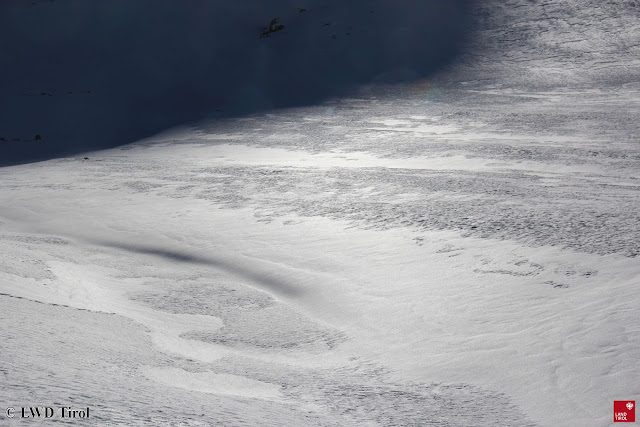New danger zones due to fresh snow and wind
A cold front passed through on Tuesday, 28.01, brought more than 50 cm of fresh snow regionally during Wednesday night 29.01.
 |
| Most of the snow fell in northwestern Tirol and northern East Tirol. |
 |
| Weather last week. To begin with, high-pressure conditions, then weakening. Initially southerly airstream, then cold air masses moved in, winds shifted to N/NW and brought snowfall. The “Am Adamsberg” station above Galtür in Paznauntal. |
High avalanche danger for a brief spell
Avalanche danger levels increased correspondingly, danger level 4 (“high”) was declared for a short time in western and northern regions of North Tirol . This was a so-called “skier high” - in other words, a situation which is (very) critical particularly for winter sports enthusiasts. This was not a question of large-sized, damage-causing avalanches.
 |
| In declaring the danger level, numerous factors play a role. For this latest situation it was the high likelihood of releases in regions which until then had played no role in wind-protected terrain, particularly in W-N-E aspects, especially in the northern half and in ridgeline terrain. In the regions where snowfall was heaviest, we moved towards artificial solutions in the two marked squares. |
Ongoingly critical situation regionally for winter sports enthusiasts!
In the interim, danger levels have receded. Ongoingly there is still avalanche danger for winter sports enthusiasts which should not be underestimated. Special caution is urged in non-tracked backcountry terrain (especially in northern half) and in untracked freeriding terrain. In addition, in ridgeline E-SE steep terrain, fresh, sometimes deep and easily triggered snowdrift masses have formed. Ascending altitude increases their likelihood of triggering.
Naturally triggered avalanches. Artificially triggered avalanches
Looking at the naturally triggered avalanche activity of this last week, along with the successes with explosives, they varied widely.
Naturally triggered avalanches were registered mostly on non-tracked, shady and leeward slopes, adjacent to ridgelines, in very steep terrain, as expected. Avalanches were mostly medium-sized (magnitude 2), in isolated cases also large-sized (magnitude 3).
Increasingly frequent reports of naturally triggered avalanches were received particularly in the Stubai Alps, also in the Verwall Massif. Few naturally triggered avalanches were registered in the Ötztal Alps. Similar conditions were registered in the freeriding terrain of the Arlberg and the regions of the Tux and Kitzbühel Alps where snow was shallow.
 |
| Naturally triggered slab avalanche in northern Stubai Alps. Classic danger zone: shady weak layer until now unaffected, expansively metamorphosed old snowpack surface. (photo: 30.01.2020) |
 |
| Naturally triggered slab avalanche in Griesskogel Massif. Shady, steep terrain unaffected-by-wind. (photo: 30.01.2020) |
 |
| Slab avalanche adjacent to ridgeline in Venegiger Massif (photo: 30.01.2020) |
 |
| Ridgeline slab. Weisskugel. (photo: 30.01.2020) |
 |
| Kappel ski area: left, a slab released naturally; right, released by explosives. (photo: 30.01.2020) |
The artificial triggerings by explosives in the Kappl ski area were deemed successful. This was also the case in Kühtal and Seegrube above Innsbruck. Lesser successes were registered in the Arlberg region and the ski areas of the southern Ötztal Alps.
 |
| Successful artificial triggerings through explosives near Kühtal ski area. (photo: 30.01.2020) |
 |
| Successful artificial triggerings on the Seegrube. The highly varied fracture surfaces are interesting. Probably graupel played a part (also in blanketed powder during the period of snowfall). |
Avalanche releases in which persons were involved
On 28.01 two ice climbers in Innergschlöss were surprised by an avalanche in the so-called Schildfall when they were (after rapelling) in a 40-degrees gradient part of the wall. One person was swept along, but was able to reach the valley on his own.
Today, 30.01, two avalanche reports were received at headquarters. Each came from the Arlberg region. “In der Riffle” - one person was swept along, but was able to free himself and was then in treatment by mountain rescue, according to headquarters. In the avalanche at “Vorderen Rendl” no persons were buried in snow masses.
 |
| Ridgeline slabs are visible in photo. In foreground, two ski tracks leading out of the slab. Hochgurgl. (photo: 30.01.2020) |
What’s next? Avalanche danger levels will increase...
In the next few days, weather will be turbulent and far too mild for the season. A warm front moving in tomorrow, Friday, 31.01.2020, will bring some rain up to 1800-2000 m. Only at high altitudes will there be some fresh snow, according to ZAMG Weather Service. Starting on Sunday, 02.02.2020, a persistent, stormy W/NW airstream will predominate which will bring very moist air masses to the northern flank of the Alps. The snowfall level will ascend accordingly.
 |
| As a result of warmth and rain, glide-snow avalanches will increasingly become a problem. Dristköpfl. (photo: 29.01.2020) |
Otherwise worthy of note.
The ZAMG Weather Service reports that January 2020 was one of the three warmest months in recorded history. Other attributes of the month of January: mild, dry, sunny.
Dust from the Sahara desert...
 |
| Dust and sand from the Sahara desert was observed in the air throughout the land during the week. Rastkogel, Tux Alps. (photo: 24.01.2020) |
 |
| New snowdrift masses were generated in the heights today, 30.01.2020. Stubai Glacier. |
 |
| Strong winds set their stamp on the snowpack surface. Tux Alps. (photo; 30.01.2020) |
 |
| Comparatively favourable situation in East Tirol, apart from Main Alpine Ridge. (photo: 30.01.2020) |
 |
| Wintery weather with massive graupel showers on 28.01. Brief storm gusts up to 160 km/hr. Some ski areas had problems with that. (photo: 28.01.2020) |
 |
| Graupel throughout the land. In some places the graupel layers were deeply embedded inside the layers of fresh fallen snow. In photo, Defereggental. (photo: 28.01.2020) |





















































